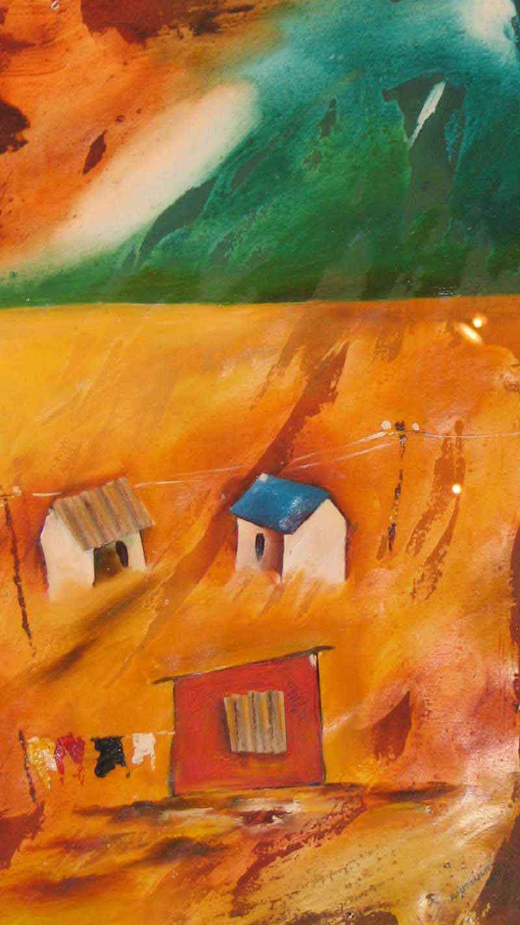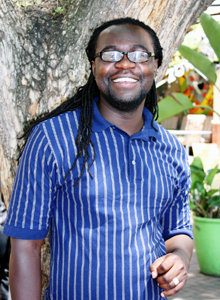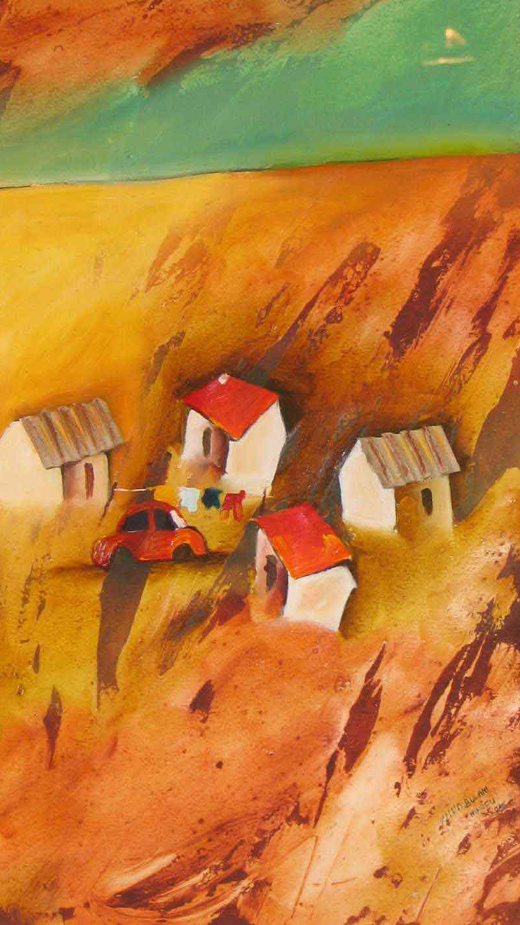It
is the consistency of representation of the humble domestic
structures against a dramatic colour-saturated landscape that
encourages the viewer to consider Mpofu's rigid loyalty to
the genre of landscape and its unvarying contents.
Does Mpofu's fidelity to form and content speak of a purely
aesthetic venture in which Mpofu is taking advantage of his
paintings' commercial appeal to local and foreign buyers?
Or, given Zimbabwe's recent tragic political and social history,
is the artist using art as an instrument of critical analysis?
Is Mpofu using the recurrent dwelling motif to suggest that
on the wind-torn canvas of Zimbabwe, people are still living
there? If the viewer believes the latter to be true, and if
art is – as many artists and writers posit – the
criticism of society and life, then the viewer is challenged
to identify exactly what Khumbulani Mpofu is criticising about
contemporary society and life in his homeland, Zimbabwe.
The gallery didn’t keep all of Mpofu’s titles,
choosing to give more expressive titles than the simple Farm
landscape 1, Farm landscape 2, Going Home and My Red Beetle
that Mpofu had given them. The gallery assigned Before the
Storm, The Lonely Place, My Home Time, Farmland and Squatter
Camp. The titles that appear to have the most meaningful connection
to the content of the paintings are Before the Storm and The
Lonely Place. It is variations on the themes of these two
titles that probably best describe the vivid African landscapes
by Mpofu, who has had permanent exhibitions in the National
Art Galleries in Harare and Bulawayo since 1996.
In Squatter Camp roofs droop over the one-eyed dwellings like
tsotsi hats. The open doorways are black eyes in bone-white
wall faces. The lethargic warm air currents lift the dust
into half-hearted sandstorms between the rib-thin walls of
the houses. In the suffocating powder of dust, a faded red
carapace of a car lies in front of one of the shacks like
a crab shell that has been picked clean.
The only signs of life in Mpofu's unpeopled landscapes are
the crooked clotheslines, their warped support poles compliant
with the will of a relentless wind. Flapping from the snap-snap
clothesline are an ink smudge of blue jeans, a wind-twisted
scarlet cloth and a pair of brutal-red trousers. This singular
hint at life, present in all of Mpofu's paintings, is usually
situated in the foreground. It is this recurrent theme that
solicits viewers to take note of what is happening in Zimbabwe,
in the same way that the old woman quoted by writer Alexandra
Fuller in Don’t Let’s Go To The Dogs Tonight appeals
to our sense of humanity, "You people should pay attention
to what is happening in Zimbabwe, not because half of us will
die in the next few months, but because half of us will live."
Mpofu is an adept colourist and his confident technique with
the bold colours on paper, instead of canvas, is masterful.
It is when he uses the portrait format on which to render
his paintings that his colour-soaked landscapes are transformed
into the dominant and spectacular skyscapes that speak of
an immense silence. Mpofu makes no colonial attempt to tame
the wild African landscape, instead, he allows the spirit
of the continent to infuse the pictures he paints of her bold
landscapes. Mpofu understands Africa's bruised moods and he
uses her own brilliant colours to paint her. Black-breast
velvet and newborn gum-pink, brick-dust and dried blood browns,
summer-echo blue and lightning scream white. “I love
that rich red of the soil of the landscape,” he says.
Critics may ascribe Mpofu's persistence with the sparsely
inhabited landscapes to artistic stagnation, but it is more
likely that Mpofu is using his innate sense of colour and
scale to force the viewer to confront not only the intense
beauty of his country, but also the great silence that surrounds
her humanitarian crisis.
If Mpofu is painting his homeland, then so too must he be
painting the great empty silence of it. In her novel The Stone
Virgins, the late Zimbabwean writer, Yvonne Vera, describes
the landscape of her homeland as 'towering boulders of rock,
then hills and an undulating silence … dust rises higher
than the trees and boulders.'
In Brothers Under the Skin: Travels in Tyranny, Christopher
Hope writes 'What struck me as I travelled across the burning
land was the great silence. …you had the feeling that
this was a country in hiding.' Throughout his narrative Hope
conjures up images that concur uncannily with the strong imagery
in Mpofu's paintings, real and implied: 'the warm air currents
… the occasional wrecked car … the high blue sky
… the eerie silence … a palpable adulteration
of the light … a mute and mutinous, edgy, hateful silence
of fear … there is the wind … this strange humped
waiting emptiness …hushed immensity ….' This is
what there is to see in Mpofu's paintings; it is what is not
visible that is more disturbing. There are no trees, no flowers,
no birds, no wild animals. There are no crops, no livestock,
no smoke rising from a communal fire. There is no laughter,
there are no screams, there is no sound. There are no people.
It is this nothingness, this empty silence, that is the true
drama of Mpofu's art.
It is for the viewer to decide whether Mpofu's art is an expression
of place or an expression of despair. What is important in
Mpofu's art though, is important of all art: that even during
times of extreme crisis art persists to create a record of
history.













![]()
![]()
![]()
![]()




